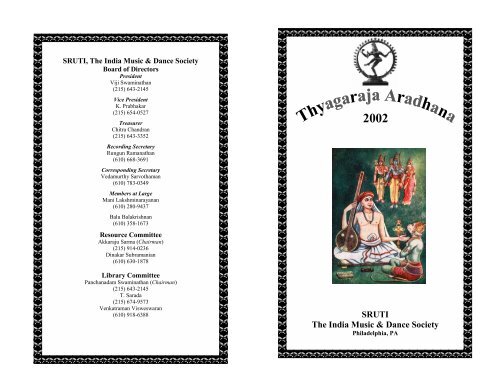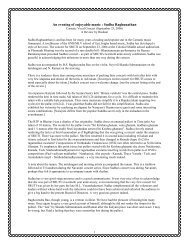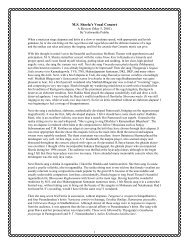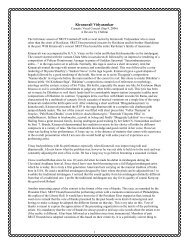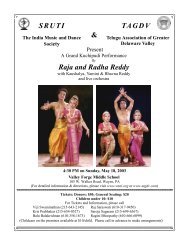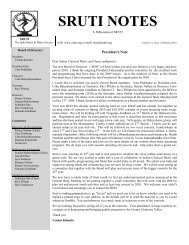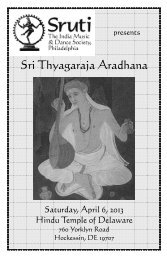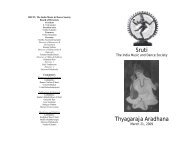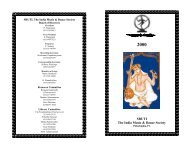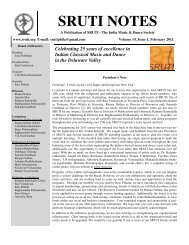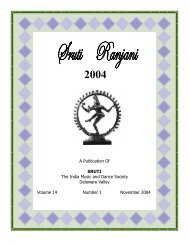2002 - Sruti
2002 - Sruti
2002 - Sruti
Create successful ePaper yourself
Turn your PDF publications into a flip-book with our unique Google optimized e-Paper software.
CONTENTSThyagaraja Aradhana in North America 1P. SwaminathanSri Rama’s Smiling Countenance 2T. SaradaGhana Raga Panchratna Kriti-s 4Library CommitteeGhana Raga Panchratna Kriti-s 6(Sahithya & Meaning)Differences between Western and Carnatic Music 16Janani PrabhakarRagas Galore 18Chetan RamamurthyMusic Crossword 19Viji Swaminathan<strong>Sruti</strong> Concert Tapes 22With the Best Compliments ofSuhasini and Srinivas ReddyWith the Best Compliments ofRajee and RamanWith the Best Compliments ofLakshmi, Saroja andH.S. AswathanarayanaWith the Best Compliments ofSarada and ParasaranWith the Best Compliments ofViji and SwaminathanVISIT SRUTI’S WEBSITEWWW.SRUTI.ORG42. N. Ramani (Flute) 1998(2)Srikant Venkataraman (Violin), Srimushnam Rajarao (Mridangam)43. Lalgudi G.J.R. Krishnan (Violon) 1998(2)Vellore Ramabhadran (Mridangam), V. Nagarajan(Kanjira)44. Sanjay Subrahmanyam (Vocal) 1998(2)A. Ananthakrishnan (Violin), Palghat Raghu (Mridangam)45. T.M. Krishna (Vocal) 1998(2)Bombay Gayathri (Violin), K.Arun Prakash (Mridangam)46. N. Ravikiran (Chitravina) 1998(2)A. Ananthakrishnan (Violin), Master Anand (Mridangam)47. Neyveli Santhanagopalan (Vocal) 1999(2)Delhi Sundararajan (Violin), Srimushnam Rajarao (Mridangam)48. Mysore Nagaraj and Manjunath (Violin) 1999(2)Thiruvarur Bhaktavatsalam (Mridangam)49. Sikkil Mala Chandrasekhar (Flute) 1999(2)H.N. Bhaskar (Violin), M. Suresh (Mridangam)50. T .N. Seshagopalan (Vocal) 2000(2)Jayasankaran Bala (Violin), Vaidyanathan (Mridangam)51. Maharajapuram Ramachandran (Vocal) 2000(2)M. Chandramouli (Violin), Kumbakonam Ganesh (Mridangam)52. M.S. Gopalakrishnan & Narmada (Violin) 2000(2)T. Bhaktavatsalam (Mridangam)53. Priya Sisters, Haripriya & Shanmukhapriya 2000(2)B. Raghavendra Rao (Violin), J. Vaidyanathan (Mridangam)54. Mysore Nagaraj & Manjunath (Violin) 2001(2)Srimushnam Raja Rao (Mridangam)55. M.S. Sheela (Vocal) 2001(2Radhika Mani (Violin), A. R. Dattatreya Sharma (Mridangam),V. Kashinath (Kanjira), Rudrapatnam Sathyakumar (Ghatam)56. P. Unnikrishnan (Vocal) 2001(2)Vittal Ramamurthy (Violin), Trichur Narendran (Mridangam).57. Hyderabad Brothers (Vocal) 2001(2)Delhi Sundararajan (violin), S. Raja Rao (mridangam)58. Bombay Jayashri (Vocal) 2001(2)R.K. Sriramkumar (Violin), K. Arun Prakash (Mridangam)
26. T.V. Sankaranarayanan (Vocal) 1994(2)T.K.V. Ramanujacharyulu (Violin), B. Harikumar (Mridangam)27. T. N. Bala (Vocal) 1994(2)Sashidhar (Violin), Balachander (Mridangam) & Murali (Khanjira)28. S.P. Ramh (Vocal) 1994(2)Shashidhar (Violin), Satish Pathakota (Mridangam)29. Charumathi Ramachandran (Vocal) 1994(2)M.S. Anantharaman (Violin), Skandaprasad (Mridangam)30. Bombay Jayashri (Vocal) 1995(2)Vittal Ramamurthy (Violin), Palani Chakravarthy (Mridangam)31. Sowmya (Vocal) 1995(2)Narmada (Violin), Balaji (Mridangam)32. Sanjay Subramaniam (Vocal) 1995(2)R.K. Sriramkumar (Violin), K. Arun Prakash (Mridangam)33. Vani Satish (Vocal) 1995(2)Satish (Violin), Mahesh Krishnamurthy (Mridangam)34. Nithyasree (Vocal) 1996(2)Embar Kannan (Violin), Siva Kumar (Mridangam)35. M.S. Sheela (Vocal) 1996(3)Nalina Mohan (Violin), Anoor Ananthakrishna Sharma(Mridangam)Sukanya Ramgopal (Ghatam)36. Jayanthi & Padmavathi (Veena Duet) 1996(2)Thiruvarur Vaidyanathan (Mridangam)37. Shashank (Flute) 1996(2)Gopinath (Violin), Satish Kumar (Mridangam),Tripunithira Radhakrishnan (Ghatam)38. O.S. Thyagarajan (Vocal) 1997(3)Srikanth Venkataraman (Violin),Srimushnam Raja Rao (Mridangam)39. Balaji Shankar 1997(2)Ganesh Prasad (Violin), Poongulam Subramaniam (Mridangam)40. T.N. Krishnan &Viji Krishnan Natarajan (Violin) 1997(2)B. Harikumar (Mridangam), Vaikkom R. Gopalakrishnan (Ghatam)41. Kadri Gopalanath (Saxophone) 1997(2)Kanyakumari (Violin), Guruvayur Durai (Mridangam)24Thyagaraja Aradhana In North AmericaP. SwaminathanOn Mar 2, <strong>2002</strong> SRUTI will be celebrating Thyagaraja Aradhana for the 15thyear in a row (officially). Of late I witness numerous organizations observe thearadhana for the savant in the Northeast as well as the rest of USA. It is very impressiveto see a lot of enthusiasm among the lovers of carnatic music in NorthAmerica to honor Saint Thyagaraja, a legendary vaggeyakara from the 19th century.Thyagaraja Aradhana is observed not only in North America but also inother parts of the world like London, Europe, Australia, Malaysia, Singapore andthe list goes on. The other day I read from the web that Thyagaraja Aradhanawas celebrated in Muscat. Who else other than Saint Thayagaraja can bringpeace and happiness to the troubled Middle East?Thyagaraja Aradhana is celebrated on pushya bahula panchami, the day thesaint attained samadhi (which usually falls during the last week of January or theI week of February) in Thiruvaiyaru, where Thyagaraja spent his last years. It isa week long celebration wherein artists, professional as well amateur, render thecompositions of Thyagaraja. The celebration starts with unchavrithi followed bychoral singing of the Pancharatna krithis and individual participation. Doordarshanin India telecasts the weeklong celebration in Thiruvaiyaru.In contrast the celebrations in North America is not restricted to the pushyabahula panchami day. Instead the Aradhana is observed anytime during themonths of January through May. The time and place are determined by the presentingorganization depending on their calendar of events and not on the bahulapanchami. The format of the celebration is also different from organization toorganization. However, most of them have group singing of Pancharatna krithisat the beginning of the celebration. In addition to musical experience, Thyagarajahelps to bring families and friends together during the celebration.I am extremely delighted and grateful to SRUTI for arranging ThyagarajaAradhana every year so that my family and I can participate. The following aresome of my thoughts and suggestions for SRUTI in particular and other organizationsin general which will help improve the over all observance.• The aradhana celebration should be conducted as close to the bahulapanchami as possible; after all we are paying homage to Thyagaraja.• During the celebration only Thyagaraja’s compositions should be rendered.The celebration is to pay tribute to Thyagaraja who revolutionized carnaticmusic with his brilliant compositions as we experience it today. He was andis a legendary composer. Competent artists should also make every effort torender his krithis in as detail and artistic form as possible complete withmanodharma element. In US, I have noticed time and again that even accomplishedsenior artists with a vast repertoire render non-Thyagaraja compositionduring the savant’s aradhana. At least in SRUTI we should try to avoidthis.• Every effort should be made to bring out the various krithis (some of them arerare and some of them are never performed), of the savant. This will enable usto appreciate Thyagaraja better. Every effort should be made to increase thepublic awareness of Thyagaraja. All the presenting organizations in generaland SRUTI in particular should strive to provide a forum towards this goal.1
Der Wirtschaftler Shawn Hattingh vom Centre for Civil Society an der Universität vonKwaZulu-Natal brachte es im Oktober 2007 auf den Punkt: „Durch eine Kombinationaus Handel und Kredit blutet Simbabwe buchstäblich aus. Geld fließt nach Südafrikaab für Importe wie Benzin, Strom und Mais. Um das Geld aufzubringen, werden beisüdafrikanischen Banken Kredite aufgenommen. Die müssen zu hohen Zinssätzenzurückgezahlt werden, sehr profitabel für die Banken. Wenn nicht zurückgezahltwerden kann, übernehmen die Gläubiger die Firmen der Schuldner, die dersimbabwische Staat als Sicherheiten angeboten hat.“* „ A Difficult Dialogue: Zimbabwe-South Africa economic relations since2000“, a preliminary report, Solidarity Peace Trust, 23 October 2007
Ragas GaloreChetan RamamurthyT H Y G K A R A J A A R A D H A N A C E I L E A B R A A T IN G T H A E G R E A T K A R N A T A K M U S N S I C T I A NA N D C N O M P O S E R I N H J N R S O R A E J E T W U F WY Q U A A A W C L D O Z H J Z P Z U D B H X D K A G T X H UL J M L K Y S I R Z N J I E S Q K O E O U I V N U J F H O QL W Z Y A A A M B E B A T I D E F K M Y B X A L M R R R T HN T Y T N K N L V O F A H X W V W X P O J U B C B A A W Q AP A T E G U R M I K A V A D U P J G G R Z I P G M E I H S MH V Q V I K H G F U S A K R T M G L Y D U N Y R T B Z I C PB P M T X N W M C T N R R U A P U S A Y Z V Z P R A B S P TJ G V U K A Z Z A U X A S Q R B J K R R H D G T Y W E U P PC E K U Z E H I X E N H K U M B H U V W N E L U I H E W R SR L A T U I N I L U S M M V V E V I W X T E Z W S B B U M HA F Q X B V A J G O Z I F S N G E Q M O H R Y S N T P A W FZ U B I S S K J T I L S O G V D K N X A P H H G Y R X F C QL B K M Y T F W O V O G G K A O N D R J Z S E Q E R W O Z OV W M T L Y Y S S X W U E N A L B I N I U R G V X F E M J RN Q N Q R E A W A G P A D M I S K R H E V O A B W A N Z Y JS V F O U D A Z X P L M J R D A W E N S A G C J H D O P U AY C M I C Z U I O I R E X X M L R H N S U U G U S U S H T IE H H W G D C L R B Q R T B W B U N Q P K S C X R B K T A NI S A A A Z Z C B H O M O D T M B R T A U Q U X Y E Z T I ZB D X N Y J B E H A G J U U Q N S I L A A B D S H G T W H KY X P P U A F O J I I D G W L C Z Y B Y S A L T W A F K K OQ X X D Q M N X H R J H E U V B A P X U N E F A V D W S Y SG L I M U Y A A S A O X R P Z N T Z L O Z R G N W A X I O NA Z T O Z Z F T T V Y U Y N I A G X P U B N C P Y A M Z H UV A S A N T H A O A Y O W B B P Y W C J G G I D X P Q F V OO F A X F Q Q O X D U Q I P V K M W A Z R C K B D T N T F DP F C E V Q O R Y R I K O C T U T V Z Y T N E F B V Y B I RFind the Following Ragas:ARABHI KALYANI ATTANA KANAKANGIBEGADA MOHANA BEHAG REVAGUPTIBHAIRAVA SHREE CHARUKESI SIMHARAVACHAYANATA SULINI HANUMATODI URMIKAHARI-KAMBOJI VASANTHA(Chetan Ramamurthy is a 10th grader and has been learning carnatic music for many years)evocative quality when sung. Furthermore, the charana-s have differentdhatu-s (varnamettu).It is said that, while the pathantara that is followed is of the Umayalpuramschool (as taught by Swaminatha Iyer, according to SemmangudiSrinivasa Iyer), there is not much difference between the versions ofthe three main sishya parampara-s. While all are set to Adi tala, the speedin which they are to be rendered is 1-kalai chaukam, except in the case ofthe Varali piece which is set in 2-kalai. Incidentally, the latter, as also thefact that this kriti is not usually taught by many because of an extramusicalconsideration, may be the reason why many falter when singing itas part of a chorus.As regards theme and import, it may be mentioned that, while mostof the known kriti-s of Tyagaraja are contextual and in the nature of responsesto specific situations, pleas, etc., the subjects of these five kriti-sare rather more general even while each of them conveys different moods.Another point that needs to be explained is the reason why the prefix‘ghana raga’ is attached to the Pancharatna-s. The characteristics commonlyassociated with the ghana raga-s are majesty and fulsomeness, withthe sound emanating from the navel (nabhi) and commencing with‘hoomkara’. These raga-s provide considerable scope for sangati-s both inarohana and avarohana passages. For fulsome singing, they require rigorous‘akara’ sadhakam. ‘Ghanam’ in musical parlance is interpreted to denotea weighty, substantial style; a branch of manodharma sangeeta orcreative music wherein a raga is expounded in the style of tanam but thespeed of singing is very fast (Ref. Dictionary of South Indian Music andMusicians by Prof. P. Sambamoorthy, Vol II). However, the grouping ofthe kritis does not seem to be only because they are all in Ghana ragas.Except for Gaula in which Thyagaraja composed only one kriti, there aremore than one in the other four ragas.Though the five raga-s traditionally referred to as ghana raga-s arethe same in which Tyagaraja composed his Pancharatna-s, these are notthe only raga-s termed as ‘ghana’. Another set of raga-s so described consistsof Kedaram, Narayanagaula, Reetigaula, Saranganata and Bauli.Punnagavarali also has been cited as a ghana raga.Thus, the grouping of the kritis as the Ghana Raga Pancharathnaseems to be the result of a consensus of opinions that these compositionsin the 5 ragas Nattai, Gaulai, Arabhi, Sri, and Varali, are the most scholarlycontribution of Thyagaraja to South Indian Music. The composer hascondensed in these five immortal gems, all his musical genius, his boundlessdevotion to God and the profound wisdom of the Vedanta teaching.[Compiled by Library Committee. Excerpts have been taken from an articlein the <strong>Sruti</strong> (India) magazine: Thyagaraja’s Ghanaraga Panchartna byManna Srinivasan]205
GHANA RĀGA PANCHARATHNA KRITIS1. Jagadānanda KārakaRāgam—Nāta 36th Mela Janyam Thālam—ĀdiPallavi:Jagadānanda kāraka Jaya Jānaki prānanāyakaAnupallavi:Gaganādhipa sathkulaja Rāja Rājeswarāsugunākara surasēvya bhavyadāyaka sadā sakalaClues for the crossword puzzle on page(solution on page 21)AcrossCharanās:1. Amara thāraka nichaya kumudahitha paripūrnanaghasura surapūja dadhi payōdhi vāsa haranasundarathara vadana sudhāmaya vachō brinda Gōvindasānanda māvarājarāpta subhakarānēka2. Nigama nīrajāmrutaja pōshakānimisha vairivārida samīrana khaga thuranga satkavi hrudālaya aganithavānarādhipa nathāmghri yuga3. Indra nīla mani sannibhāpaghana Chandra Sūryanayanāpramēyavāgīndra janaka sakalēsa subhra Nāgēndra sayana samana vairisannuta4. Pāda vijitha mouni sāpa sava paripāla vara mantra grahana lōlaparama sāntha chittha janaka jādhipa sarōja bhava varadākhilaDown5. Srushti sthityanta kāraka amita kāmita phalada asāmāna gāthra Sacheepathi suthāpdhi madahara anurāga rājitha katha sarahitha6. Sajjana māna sāpdhi sudhākara kusuma vimāna surasā ripu karāpjalālitacharana avaguna suragana mada harana sanātanā janutha7. Omkāra panjarakīra purahara sarōjabhava Kēsavādi rūpa vāsava-ripuJanakānthaka kalādharāpta ghrunākara saranāgatha janapālanasumanō-ramana nirvikāra nigamasārathara8. Karadhrutha sara jālāsura madāpaharanā vanīsura surāvana kavīnabilaja mouni kruta charitra sannuta Sri Thyāgarājanutha9. Purāna purusha nru varāthmajāsritha parādhīnakara virādha rāvana virāvana anagha parāsara manōhara vikrutaThyāgarāja sannutha10. Aganitha guna kanaka chēla sāla vidalana arunābha samāna charanaapāra mahimādhbutha sukavi jana hrithsadana sura munigana vihithakalasa nīra nidhijā ramana pāpagaja Nrusimha vara Thyāgarājādinutha619
Carnatic Music CrosswordViji SwaminathanClues on the next page(Viji Swaminathan is the president of SRUTI and is a frequent contributorto SRUTI publications)18MeaningPallaviCreator of great happiness (bliss) to the universe! Victory (glory) toYou, the beloved husband of Janaki!AnupallaviDescendent of Sun, the lord of the skies, you are the king of allkings, and all treasures that are good. Worshipped by devas, Youbestow good things to the universe.Caranam1. You are the moon amongst the galaxy of devas (stars); You givewithout restraint to them. All-inclusive whole, You have no sins;You are an expert in stealing yogurt and milk pails. Your words dripnectar, You have a beautiful countenance; You are always blissful;You are the Lord of Lakshmi. You do not age; You give plenty ofYour grace and all good things to Your seekers.2. You are the holder of the immortal teachings of the Vedas. You arethe destroyer of the enemies of devas just like the hurricane that dispersesthe clouds. The sacred Garuda is Your carrier; You reside inthe hearts of great poets; the king of the monkeys worships You.3. Your body is like Lapis Lazuli (Indra Nila). Your two eyes are thesun and the moon. You are beyond imagination; You are the fatherof Brahma. You are the Lord of all; your bed is the white, bright kingof cobras; Siva, the conqueror of the God of death, worships You.4. Your holy feet dispelled the curse of Gautama; You protected theYagas. You learnt eagerly the sacred mantras (bala and atibala fromViswamitra). You are very calm. You are the lord of Sita and Yougave boons to the lotus born Brahma.5. You perform the creation, the protection and the destruction and fulfillthe limitless desires of all; Your beauty is unparalleled. Youquenched the arrogance of Vali, Indra’s son and the king of theoceans. You are the essence of the epic Ramayana, known for itsmelody and devotion.6. You are the moon to the sweet ocean of the good people’s hearts;You ride on the Pushpaka Vimana (airborne chariot). Hanuman tenderlycaresses your feet. You destroyed the haughtiness of the evilmindedasuras. You are immortal; Brahma worships you.7. You are Siva who destroyed the cities. You are the lotus bornBrahma, You are Maha Vishnu. You killed Ravana, the father of Indrajit.You dwell in all arts and sciences. You are the friend of Siva,the wearer of the crescent moon. Compassion resides in You. Youprotect all your devotees dedicated to You. You delight your goodhearteddevotees. You are Immortal. You are the essence of Vedas.7
Bhava, Raga and Tala and their beauty. They enjoy long lives withno misery or unhappiness. They are the friends of Tyagaraja.10. When Bhakti increases and explodes threefold they think only ofyour holy name. They are the Bhaktas of Rama; they are the worshippersof the chosen deity of Tyagaraja.CommentsBhava: Humility and gratitude to the Lord. Acknowledgement of Baghawathas.Raga: Sriraga, to denote no false humility but manly recognition.(Sriraga is known as a masculine Raga). Language: Combination ofboth spoken and written Telugu, to express both sentiments, praises forthe Lord and equality with other Bhaktas.(T. Sarada & P. Swaminathan compiled the meanings for the PancharatnaKrithis, based on the following literature:1. The Pancaratna Kirtanas of Sri Tyagaraja Swamigal. (Sri Semmangudi,Sri Musiri, Sri T. K.Govinda Rao and edited by T. S. Partasarati.Sri Sat guru Sangeeta Samaj Publication. Madras.1975.2. Tyagaraja Ganamrutam Volumes, 1, 3 and 4. S. K. SitaDevi, Ganamruta,Pub. Madras. 1967, 19771 and 1974.3. Spiritual Heritage of Tyagaraja. C. Ramanujachari and V. Raghavan.Sri Ramakrishna Mutt, Madras, 1966.)The Differences between Western Classical and Carnatic MusicBy Janani PrabhakarWhat is music? It is defined as a “form of art with vocal, instrumental,or mechanical sounds having rhythm, melody, or harmony” (Merriam-Webster). This definition can be applied to music around the world. Thefactors that make each form of music different are the themes, compositions,modes, and structures used in each particular art form. These varyingfactors make the music from the country unique and also help identifyits people’s culture and lifestyle. Being a student of both South Indianand Western classical music, the difference between these two artforms has been, for me, a very intriguing concept. The variations betweenthe two forms, conflicting in their themes, composition, modes,and structure, help to bring out their individual beauty.Western classical music is “equally tempered” with 12 keys per octave;where as Indian classical music is “just tempered” with 22 keys peroctave. In western classical music, an equally tempered key means thatan octave is divided into twelve geometrically equal keys, each key separatedby a specific ratio. This is not the case in Indian classical musicwhere a lot of oscillations of the note and nuances are required while renderingthe music. Hence twelve keys per octave are not sufficient. A justtempered scale is one where the octave is not divided into equal keys, butwhere the specific ratio that separates the keys is variable. This requireseach individual key to be tuned separately. When playing a piano, whichuses the “equally tempered” scale, the notes jump from one to another,167. Dhrushtiki sārambagu lalanā sadanārbhaka sēnāmitha dhanādulanu,dēvādidēva nera nammithini gākanu padābja bhajanambu marachina8. Chakkani mukha kamalambunu sadā nā madilō smarana lēkanēdurmadandha janula kōri parithāpamulachē dagili nogili durvishayadurāsalanu rōyalēka sathathama parādhinai chapalachitthudanaina9. Mānavathanu durlabha manuchu nenchi paramānanda monda-lēka;mada matsara kāma lōbha mōhulaku dāsudai mōsabōthi gāka;modati-kulajudaguchu bhuvini sudrula panulu salpuchu nuntinigāka; narādhamulanu kōri sārahina madamulanu sādhimpathārumāru10. Sathulaku konnallasthikai suthulaku konnāllu dhana thathulakaithirigithi nayyā Thyāgarājāptha ituvantiMeaningPallaviWhich lord's son would protect an errant (or misbehaving) personlike me?AnupallaviI have been lured by earthly pleasures every moment.Caranam1. You are the moon that made the lily of Lakshmi’s heart blossom;You are beyond imagination.2. Not realizing that You are immanent, I lost my thinking.3. Right form the young age, I did not enjoy the ambrosia of your Bajans(prayers) but indulged in vain disputes without a rhyme or reason.4. Desirous of other’s wealth, I earned my living by flattery and deception.5. I spent all the time thinking that the ultimate purpose of life is onlycomfortable living.6. Just to attract and please ignorant dancers, pleasure seekers, nonspiritualmen and women, I preached them. I was proud posing myselfas a great devotee without understanding or grasping swaras,talas and all.7. Oh lord of lords! I was carried away by attraction to material wealth,good-looking women, property, children, servants and great wealth,and forgot to worship your lotus feet.8. Instead of contemplating on your lotus face in my mind, I sought thecompany of bad-minded people and lived a criminal life. Unable tocontrol my carnal desires I always did the wrong things and becamemore vulnerable and susceptible. With my weak and vacillating mindI lived a low life.9
9. Instead of appreciating the rare human birth, I have, I became aslave to anger, jealousy, sex, greed and desire and so am lost. Fromthe high caste of seeking knowledge, I became interested in physicalpleasures. I became quarrelsome about non-essential religiousissues and have been treading an erratic path.10. I spent some days on women, some on material wealth and some incollecting wealth. Oh friend of Tyagaraja, for sinners like me,which son of emperor would help?CommentsBhava: Vatsalya, child to parent. I am your helpless erring child. Sohelp me. Mood: Pathos. Language: Spoken Telugu to reflect closeness,familiarity and liberty taken.3. SadinchaneRāgam—Ārabhi 29th Mela Janyam Thālam—ĀdiPallavi:Sādhinchanē O ManasāAnupallavi:Bōdhinchina sanmārga-vachanamula bōnku-chēsi thā-pattinapattuCharanasSamayāniki thagu mātalādenē1. Dēvaki Vasudēvula nēginchinatu2. Rangēsudu sadgangā janakudu sangītha sampradāyakudu3. Gōpī-jana-Manōratha Mosanga-lēkanē gēliyu chēsē-vādu4. Vanithala sadā sokka jēyuchunu mrokka vhēsē Paramātmudadhiyu-gākaYasōdha thanayudanchu mudhambunanu muddhubettanavvuchundu hari5. Parama bhaktha vatsaludu suguna pārāvārundu ājanma managhudīkali bādhala thīrchu vādanuchunē hrudayambujamunajūchuchundaga6. Harē Rāmachandra Raghukulēsa mrudubhāsha sēshasayanaparanārī sōdharāja virāja thuraga rājarājanutha nirāmayāpaghanasarasīruha dhalāksha yanuchu vēdukonnanu thā brōvakanu7. Sri Venkatēsa svaprakāsa sarvōnnatha sajjanamānasa nikēthanakankāmbaradhara lasanmakuta kundala virājitha harē! yanuchu nēpogadagā Thyāgarāja-gēyudu mānavēndrudaina Rāmachandrudusaukhyamulache chirāyuvul galigi niravadhi sukhātmulaiThyāgarājātmulaina vār+endarō10. Prema muppiri gonu vēla nāmamunu dalachē-vāru RāmabhakthudainaThyāgarāja-nuthuniki nija-dāsulainavar+endarōMeaningPallaviThere are so many great souls and I bow to all of them.AnupallaviThese great souls keep the moon complexioned Lord’s beautifulform in their heart lotus, see them and enjoy bliss.Caranam1. Oh, (Lord) one who is attracted by Sama gana, and having the faceequal to Manmatha! These souls are the greatest amongst theblessed souls.2. They have controlled the mischief of the monkey like mind andare able to visualize effectively and praise your form.3. At your lotus feet they are offering their heart lotuses.4. Knowing that you are the “Paratparan”, who protects the weak anddowntrodden, they sing your praises with true Bhakti, holding rapportwith you and with profound knowledge of proper musicaltechniques of Swaras, Laya, and Raga.5. They wear garlands made of the jewels that are Hari’s divinequalities; their hearts are full of devotion and love, and they lookwith compassion on everything in the world.6. With their very eyes, they see the Lord walking elegantly, everysingle day, get goose bumps out of that experience and are immersedin the ocean of bliss. They have such great fame.7. Like well known great rishis and devotees like the sun, moon,Sanaka, Sanandana, the chiefs of the eight directions, the devas,Kim Purushas, Prahlada, Narada, Tumburu, Anjaneya, Siva wearingthe crescent moon, Suka, Brahma, all the worshipers of Brahmanand the pure, the immortals and those who enjoy the ultimatebliss. All these and such others who are not mentioned here,8. Those who daily sing your glory and your blessed form, the greatnessof your name, your prowess, courage, peacefulness, truthfulwords, and know your intent to destroy false beliefs,9. They know Srimad Bhagawatham, Ramayana, Gita, all <strong>Sruti</strong>s,Sastras, Puranas and the inner meanings of all these. They knowthe six religions like Saivam, their purport, the inner feelings andideas of the thirty-three crore Devas. They are well versed in1510
5. Endarō MahānubhāvuluRāgam—Sri 22nd Mela Janyam Thālam—ĀdiPallavi:Endarō mahānubhāvulu andariki vandanamuluAnupallavi:Chanduru varnuni anda chandamunu hrudayā Aravindamunajùchibrahmānanda manubhavinchuvār+endarōCharanas:1. Sāma-gāna-lōla manasija lāvanya dhanya mùrdhanyul+endarō2. Mānasa vana-chara vara sanchāramu nilipi mùrthi bāguga podaganēvār+endarō3. Saraguna pādamulaku svāntamanu sarōjamunu samarpanamusēyuvār+endarō4. Pathitha pāvanudanē parāthparuni gurinchi paramārthamagunijamārgamu thonu pāduchunu sallāpamuthō swara layādirāgamula eliyuvār+endarō5. Hari-guna manimaya saramulu galamuna sōbhillu bhakthakotulilalōthelivitho chelimithō karunagalgi jagamellanu sudhādrushtichē brōchuvār+endarō6. Hoyalumīra nadalu kalgu sarasuni sadā kanula jùchuchunu pulakasarīrulaiananda payōdhi nimagnulai mudambunanu yasamugalavār+endarō7. Parama bhāgavatha mouni vara sasi vibhakara Sanaksanandanadigīsa sura kimpurusha kanakasipu suta Nārada Thumburupavanasùnu Bālachandra dhara suka sarōjabhavabhùsuravarulu- parama pāvanulu ghanulu sāsvathulukamalabhava sukhamu sadānubhavulu gāka endarō8. Nī mēnu nāma vaibhavammulanu nī parākrama dhairyamula sānthamānasamu nīvulanu vachana satyamunu Raghuvara! Nī yedasadbhakthiyu janinchakanu durmathamulanu kalla chēsinatti nīmadi neringi santhathambunanu guna-bhajanānanda kīrtanamusēyuvār endarō9. Bhāgavatha Rāmāyana Gītādi Sruthi Sāsthra Purānapumarmamulan Sivādi Shanmathamula gùdhamula muppadi mukkōtisurāntharangamula bhāvamula neringi bhāva rāga layādi148. Sadhbhakthula nadatha litlanenē amarikagā nā; pūja-konenēalugavaddhanenē; Vimukhulathō jērabōku-manenē; Vetha galginathālukommanenē; Damasamādi sukhadāyakudagu SriThyāgarājanuthudu chentha rākanēMeaningPallaviListen, Oh mind, He has accomplished (what He wanted)AnupallaviWhat spiritual teachings He gave the world He proved them falseand took his stand adamantlyCaranamHe speaks cleverly for every context that suits the occasion1. Just as He made Devaki and Vasudeva suffer so much,2. He is the originator of the cosmic play. He is the father ofGanges. He has nurtured the celestial music from birth and3. He laughed and teased the Gopikas without fulfilling their desires.4. He makes all women go into raptures thinking about Him andin the end makes them worship only Him. Besides that whenthat innocent and naive Yasoda hugged and kissed Him(thinking He was her child), He gave her mock smiles,(laughed at her ignorance).5. He has great love for His sincere devotees; He is like an oceanof good qualities. He is Hari who is above sins. Till the end ofthe “Kali” time cycle, He will remove all evils. While allalong, I have been thinking like this,6. Hey Hari! Ramacandra! The leader of the Raghuvamsa, whosespeech flows with nectar; you sleep on the Adisesha. You treatthe women other than your wife as sisters. You have no birth ordeath. You keep the sacred Garuda as your vehicle. Kings andemperors alike worship you. Sickness cannot approach you.Your body is so pure and your eyes are like the petals of lotusflower. Saying so, I have been pleading and worshipping you.But without protecting me on His own,7. You are Sri Venkatesa. You are self-illuminating. You arehigher than the highest. You reside in the hearts of all goodpeople. You wear golden robes and scintillating earrings. Youglow and you are Hari. Thus I have been praising you. Sungby Tyagaraja, He is the king of kings and He is Ramacandraand8. The lives and doings of good devotees will be such, He said.He stayed so relaxed and accepted with obvious pleasure all11
my prayers and offerings. Do not get angry, He said. Do not associatewith non-believers, who do not believe in me, He said. Ifthere is suffering, bear it, He said. Control your senses, He said.Be patient and calm, He said. He who gives happiness and He whois worshipped by Tyagaraja, without even coming near me.CommentsBhava: Sakha or friend on equal footing and so teasing and finding faultsworks well. Raga: Arabi, used to denote anger is used to present“nindastuti”. Language: Spoken Telugu for intimacy and the complaining,chiding tone.4. Kanakana RuchiraRāgam—Varāli 39th Mela Thālam—ĀdiPallavi:Kana Kana Ruchirā Kanakavasana NinnuAnupallavi:Dina Dinamunu Manasuna Chanavuna NinnuCharanams:1. Pālugāru mōmuna Sriyapāra mahima danaru ninnu2 Thala Thala-manu mukha-kala galigina Sītha kulukuchunōra-kannulanu jūchē ninnu3. Bālārkābha suchēla manimaya mālālankrutha kandhara Sarasijākshavara kapōla suruchira kiritadhara sathathambu manasāraga4. Sāpathnīmāthayow Suruchichē-karna sūlamaina-māta vīnulachurukkana thālaka Sri Harini dhyāninchi sukhimpaga lēda yatu5. Mrugamadalalāma subhanitala varajatāyu mōkshaphaladapavanamānasutudu nīdhu mahima delpa Sīta thelisi valachisokkalēdharīthi ninnu6. Sukhāspada vimukhambudhara pavana vidēhamānasa vihārāpthasurabhūja mānitha gunāmka Chidānanda khaga thurangadhrutaradhānga parama dayākara karunārasa varunālaya bhayāpahārāSri Raghupathē7. Kāminchi prēmamīra karamula nīdu pādakamalamula battukonuvādusākshi Rāmanāma rasikudu Kailāsa sadhanudu sākshi mariyu NāradaParāsara Suka Saunaka Purandara nagajā dharaja mukhyulu sākshigādaSundarēsa sukha salāmbudhi vāsāsrithulakē8. Sathathamu prēma pūrithudagu Thyāgarāja nuta mukhajitha kumudahithavarada ninnuMeaningPallaviThe more I see you, dressed in golden robes, the greater my joy.AnupallaviDaily with love and privilege when I see you in my heart,Caranam1. The unparalleled beauty of your child like face shines with exceptionalgrandeur. Seeing, Sita, with youthful glow and elegance bestowing herfavored glances through the corners of her eyes,3. Your dress shines like the early morning sun. Your neck is decorated withgarlands made of precious stones, you are lotus petal eyed, your cheeks arebeautiful and your crown is dazzling. Always seeing you with rapt attention,4. Hurt and pained by the sharp words of his step mother, Suruci, Druvaprayed to you, Sri Hari, with concentration and was rewarded with yourblessings. And5. Kasturi Tilakam is on your handsome forehead. You gave salvation to theheroic Jatayu. From Hanuman, son of Vayu, Sita heard your glory and wassmitten with great desire to be with you right away. Similarly,6. You are the abode of contentment. You destroy your enemies that hate youlike the cyclone. You dwell in the hearts of real “yogis”. For your friendsyou give without holding back. You have qualities that deserve glorification.You are the form of bliss and existence. Your vehicle is the sacredGaruda. You hold the Chakra; you are the bestower of graces. You are thepersonification of “daya”; you are the ocean of compassion, remover offear and you are Raghupati. Seeing you,7. Hanuman who with the greatest love and devotion is holding your lotus feetis my witness. Kailasa’s lord, who is always contemplating your name, isanother witness. The sage Narada, Parasara, (Veda Vyasa’s father), Sukha,Saunaka, Indra, Parvati and Sita are all witnesses. Sundaresa and Sri Narayanawho is lying on the ocean of bliss, both give their devotees such joyand seeing that,8. Always full of love, Tyagaraja worships you. Your face has won over eventhe moon (in beauty). You are the giver of boons. Seeing you is a pleasureCommentsBhava: Kanta Bhava.; Raga: Varali although not known for expressingprema Bhava, Tyagaraja has used it on two other occasions to express SringaraBhava. the songs are, “Eti janmamidi” and Vadunundunade”. Mood:He is the Nayaki to Rama’s Nayaka expressing steady (Stayi Bhava) andsublime love. Language: To show closeness and endearment, Vaduka(Spoken )Telugu.1213


